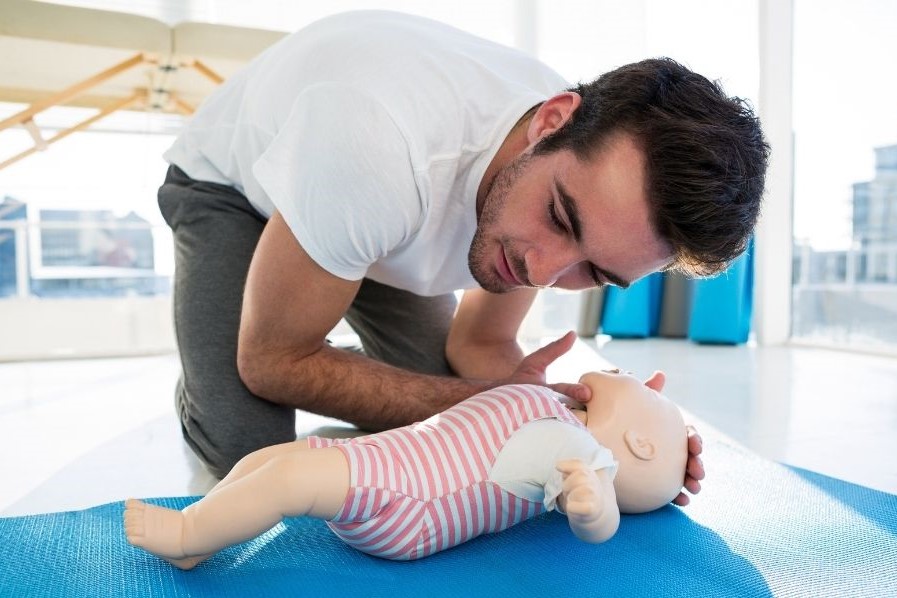
Resuscitation manoeuvres: cardiac massage on children
Cardiac massage on children is performed by pressing on the lower half of the sternum and compressing the chest by about 1/3, for about 5 centimetres, at a rate between 100 and 120 compressions per minute
Use of hands and fingers in infant cardiac massage
In babies and infants, two fingers are used, taking care to keep the head still and in position.
The fingers may be those of the same hand or the two thumbs: in this case, help is given for positioning the head.
In children, one hand is typically used; if the patient’s build allows, the classic two-handed technique can also be used.
The two-handed technique is less tiring and, if resuscitation is prolonged, allows the rescuer to maintain a good performance.
This gives an important insight into how crucial it is (if at all) to perform resuscitation with two rescuers in order to maintain optimal cerebral perfusion.
QUALITY AED? VISIT THE ZOLL BOOTH AT EMERGENCY EXPO
Cardiac massage in children, the search for the compression point
Searching for the compression point
- Infant: place the index finger of one hand on the sternum just below a line joining the nipples; the middle and ring fingers of the same hand placed in contact with the index finger below it are in the position for massage.
- Child: slide the index and middle fingers of one hand along the lower rib margin until they meet the sternum. Place two fingers, the index and middle fingers, on the lower part of the sternum so that the middle finger is in contact with the sterno-costal junction identified earlier; the position for massage is found by placing the palm of the other hand on the sternum just above the two fingers.
CHILD HEALTH: LEARN MORE ABOUT MEDICHILD BY VISITING THE BOOTH AT EMERGENCY EXPO
Compression method:
- Infant: One can choose between the two-handed technique and the two-finger technique. The former consists of placing the two thumbs next to each other or on top of each other on the sternum in the previously identified position; embrace the whole thorax with the other fingers of both hands up to the spine; compress the sternum with the thumbs using the strength of the hands. Two-finger technique: the middle and ring fingers are in contact with and below the index finger in the position previously identified; compress the sternum with the middle and ring fingers after lifting the index finger using arm strength. In both techniques, the sternum should be lowered with the compression of 1-1.5 cm in the infant and about 2 cm in the neonate.
- Child: kneel beside the casualty and locate the area on which to apply the overlapping hands. One locates the costal arch, two fingers above the xiphoid process, at the side of the two fingers one applies the hands (heel of the hand), exerting enough downward pressure to lower the chest by 2-4cm. The arms are hyperextended (the elbow does not flex) and perpendicular to the injured person’s chest.
Read Also:
Emergency Live Even More…Live: Download The New Free App Of Your Newspaper For IOS And Android
What Is The Difference Between Adult And Infant CPR
CPR And Neonatology: Cardiopulmonary Resuscitation In The Newborn
First Aid: How To Treat A Choking Baby
How Healthcare Providers Define Whether You’re Really Unconscious
Concussion: What It Is, What To Do, Consequences, Recovery Time
AMBU: The Impact Of Mechanical Ventilation On The Effectiveness Of CPR
Defibrillator: What It Is, How It Works, Price, Voltage, Manual And External
The Patient’s ECG: How To Read An Electrocardiogram In A Simple Way
Emergency, The ZOLL Tour Kicks Off. First Stop, Intervol: Volunteer Gabriele Tells Us About It
Proper Defibrillator Maintenance To Ensure Maximum Efficiency
First Aid: The Causes And Treatment Of Confusion
Know What To Do In Case Of Choking With Child Or Adult
Choking Children: What To Do In 5-6 Minutes?
What Is Choking? Causes, Treatment, And Prevention
Respiratory Disobstruction Manoeuvres – Anti-Suffocation In Infants


